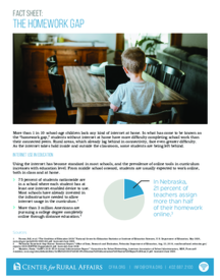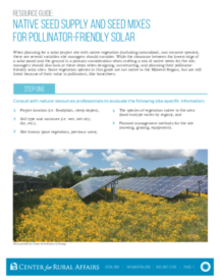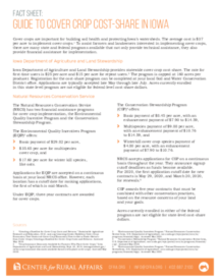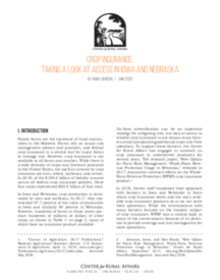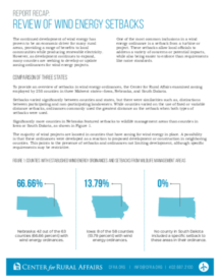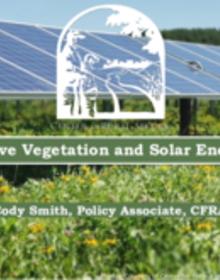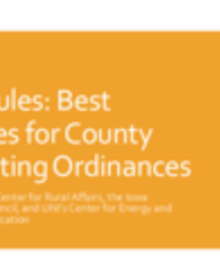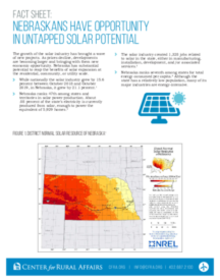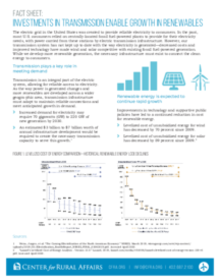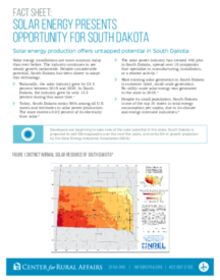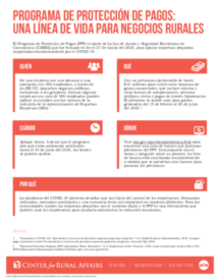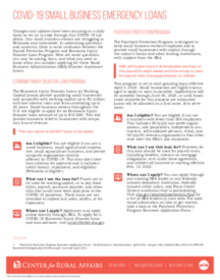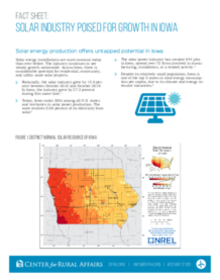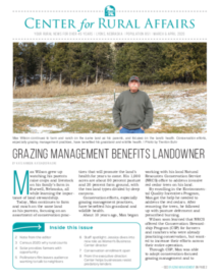We aren't afraid of the weeds. The people living in rural America deserve a serious and in-depth look at the issues and forces impacting their communities.
The first value of the Center for Rural Affairs is “RESPONSIBILITY placed upon each of us to contribute to our community and society.” So, when COVID-19 hit the communities we live and work in, our staff each felt responsible to continue the work we do to support rural America.
- Small Towns
More than 1 in 10 school-age children lack any kind of internet at home. In what has come to be known as the “homework gap,” students without internet at home have more difficulty completing school work than their connected peers. Rural areas, which already lag behind in connectivity, face even...
- Small Towns
When planning for a solar project site with native vegetation (including naturalized, non-invasive species), there are several variables site managers should consider. While the clearance between the lowest edge of a solar panel and the ground is a primary consideration when crafting a mix of native...
- Policy
Cover crops are important for building soil health and protecting Iowa’s watersheds. The average cost is $37 per acre to implement cover crops. To assist farmers and landowners interested in implementing cover crops, there are many state and federal programs available that not only provide technical...
- Farm and Food
Family farms are the backbone of rural communities in the Midwest. Farms rely on sound risk management options and practices, and federal crop insurance is a central tool for many farms to manage risk. However, crop insurance is not available to all farms and ranches. While there is a wide diversity...
- Farm and Food
The wind energy industry remains one of the fastest growing in the United States. In 2018, U.S. wind capacity increased by 8 percent, bringing total installed capacity to 96,433 megawatts (MW). An additional 35,135 MW of capacity were under development at the end of 2018—including projects that had...
- Policy
This webinar, hosted by the Center for Energy & Environmental Education at the University of Northern Iowa and the Center for Rural Affairs covers the key components of strong county-level solar ordinances with examples from Iowa and around the Midwest. Energy program staff from the Iowa...
- Policy
This webinar, hosted by the Center for Energy & Environmental Education at the University of Northern Iowa and the Center for Rural Affairs covers the key components of strong county-level solar ordinances with examples from Iowa and around the Midwest. Energy program staff from the Iowa...
- Policy
The growth of the solar industry has brought a wave of new projects. As prices decline, developments are becoming larger and bringing with them new economic opportunity. Nebraska has substantial potential to reap the benefits of solar expansion at the residential, community, or utility scale. While...
- Policy
The electric grid in the United States was created to provide reliable electricity to consumers. In the past, most U.S. consumers relied on centrally-located fossil fuel-powered plants to provide for their electricity needs, with power carried from these stations by electric transmission...
- Policy
The Center for Rural Affairs is committed to continuing our work for opportunity and justice for everyone in rural America during the rapidly evolving response to the coronavirus. COVID-19 and the ripple effects will create new challenges for rural people and rural places. Our work may look different in the days ahead, but we will continue to serve our mission in all ways possible.
- Farm and Food
- Lending
- Small Towns
Solar energy installations are more common today than ever before. The industry continues to see steady growth nationwide. Despite considerable potential, South Dakota has been slower to adopt this technology. Nationally, the solar industry grew by 23.5 percent between 2019 and 2020. In South Dakota...
- Policy
Cody Smith, policy associate at the Center for Rural Affairs, hosts this webinar on best management practices for implementing native vegetation on solar project sites in the region with Rob Davis, director of the Center for Pollinators in Energy at Fresh Energy. “Solar energy is growing at a rapid...
- Policy
The Paycheck Protection Program (PPP) is part of the Coronavirus Aid, Relief, and Economic Security (CARES) Act signed into law on March 27, 2020, to support small businesses economically impacted by COVID-19. Note: The Small Business Administration will resume accepting PPP loan applications on...
- Lending
El Programa de Protección de Pagos (PPP) es parte de La Ley de Ayuda y Seguridad Económica de Coronavirus (CARES) que fue firmado en ley el 27 de marzo del 2020, para apoyar empresas pequeñas impactadas económicamente por el COVID-19.
- Lending
Changes and updates have been occurring on a daily basis as we try to cope through this COVID-19 epidemic. Our small business owners are struggling in Nebraska and nationwide. In addressing questions and concerns, there is some confusion between the Payroll Protection Program and Economic Injury...
- Lending
The wind energy industry remains one of the fastest growing in the United States. In 2018, U.S. wind capacity increased by 8 percent, bringing total installed capacity to 96,433 megawatts (MW). An additional 35,135 MW of capacity were under development at the end of 2018—including projects that had...
- Policy
Solar energy installations are more common today than ever before. The industry continues to see steady growth nationwide. Across Iowa, there is considerable potential for residential, community, and utility-scale solar projects. Nationally, the solar industry grew by 15.6 percent between October...
- Policy
At the Center for Rural Affairs, we are happy to work with constituents like Max Wilson, who is featured on our front page. My colleague, Kate Hansen, first spoke with Max about his experience with the Conservation Stewardship Program. She told me she was so energized by his answer that he was on the top of her list to follow-up with so we can learn more.
- Small Towns
The Small Business Needs Assessment was first done by the Center for Rural Affairs in 2008. The survey has been completed every other year since. The purpose of the assessment is to determine the needs of small businesses in Nebraska as reported by small business owners and those who serve small...
- Lending



